The citrus season
+ 3 pasta recipes: broccoli orange cream pasta, lemony risotto, citrus bottoni pasta
Many people feel January is long and tiring. Personally, I'm closing the month with a cold. I went out a few days ago when it was warm in Bologna, but a strong wind carried viruses and more around. Anyway, considering that, literally, the roof tiles were flying off, and I could have been hit by something worse than a cold, I'm not complaining.
Furthermore, this year, I feel a vague sense of lightness thinking about January 2024, as a move with renovations awaited me around the corner of February. By the end of January, I was already counting how many boxes I would need, and believe me, I would have preferred to leave for the moon.
To keep our spirits high, yours and mine, I dedicate the last January newsletter to the citrus season with three recipes to brighten your table.
Although agrume production is staggered in Italy and available all year round, winter is the quintessential season for citrus fruits.
Whenever I go to the farmers' market, I meet Giuseppe, the man of citrus fruits. I observe his big, weathered hands from work and cold, proudly selling the oranges from his Calabria while telling how his work has allowed him to send his daughter to University, who is now in America but seems she will return. I love this story as much as the taste of his oranges.
However, among citrus fruits, I must confess a preference for lemons.
Think, I received a lemon tree many years ago as a gift. Honestly, it was the second time I received a tree; the first was an olive tree. Thinking about it now, it seems strange. I don't know what kind of person gets trees as gifts from others; I've never thought about it.
Anyway, my lemon tree finds shelter from the winter in the loggia of the old country house, where light streams through the windows that frame the wooden doors even when they are closed. Every year, it blooms, but it rarely bears fruit. The ones in the photo are the best I've ever used for cooking. They are from Sardinia and come from the father's garden of a friend of my husband, who always puts a few in a paper bag for me.
Finally, A grapefruit is just a lemon that saw an opportunity and took advantage of it (Oscar Wilde). This is a reminder not to forget the chance to use grapefruit, citron, and bergamot. You can cook interesting things with them, too.
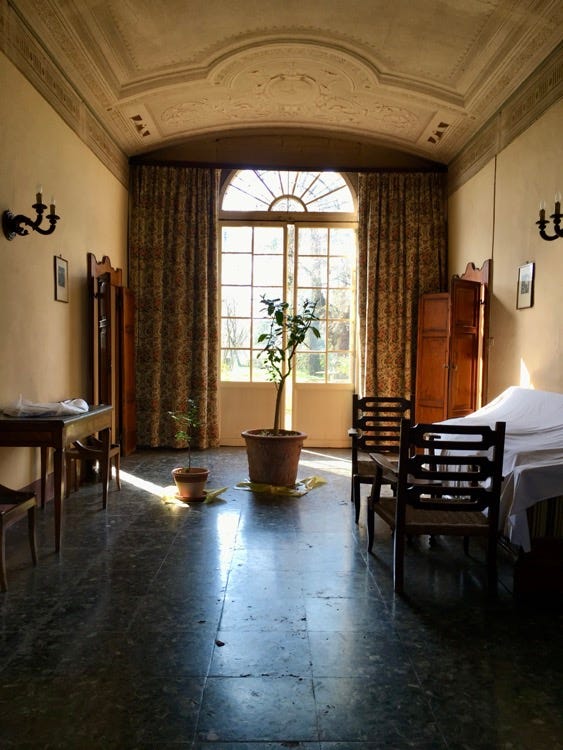
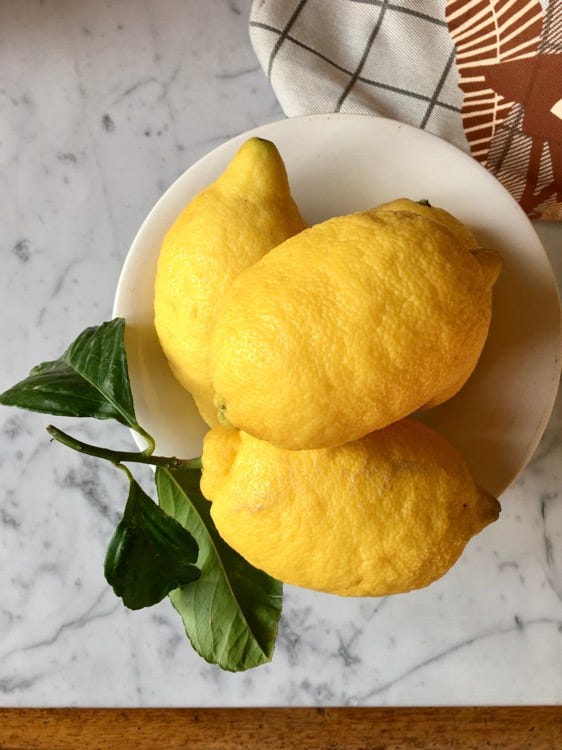
Citrus fruits on my table
Have you ever thought of winter as a colorful season?
Unlike summer, when scents and colors are fully displayed, those of winter must be sought. In the blue of a clear sky, in the peel and flesh of citrus fruits, among the emerald green tufts of crisp, pot-bellied fennel, in a box of colorful cabbage. If you have a winter color to add to this list, I look forward to reading you in the comments.
The aroma and bright color of citrus fruits remind me of summer and, at the same time, the crisp air of the winter season. I love the versatility, flavor, and fragrance of these fruits. The important thing is that they are organic, so everything, including the peel and pulp, can be used.
If I travel through the winters of the past, citrus fruits have always been on my table. Not only that, but sometimes, I repeat ancient and now out-of-date gestures such as putting the peels of oranges and lemons over radiators to scent the air.
In winter, the fruit bowl overflowed with oranges and tangerines. Besides being the fruit served at the end of the meal, they often reappeared on the table after dinner, along with nuts and hot wine, as a loveria (treat) for the adults playing cards. Loveria, an Italian word from the dialect of Romagna, refers to something you eat not out of hunger but for pleasure.
Hot wine was the name for the mulled wine from Romagna. It's worth noting that hot, sweetened wine was typical in the countryside of many regions in Italy, not just in South Tyrol. My grandmother made it with cloves, a little sugar, and, of course, orange and lemon peels.
The juice of citrus fruits, as well as the grated zest, was used to prepare both sweet and savory recipes. Grandma used pulp and zest to make jams. Not to mention the fresh juice, la spremuta, I drank during winter afternoon merende.
Over the years, I've increased the number of citrus recipes. And after two long, endless years without citrus and many other things (for health reasons), you can't imagine how happy I am to use them again.
Below, I'm sharing three pasta recipes where the fresh, tangy, and fragrant note of citrus makes all the difference. They are three vegetarian dishes; two can easily be made vegan: remove the anchovy from the pasta with broccoli and the butter and Parmigiano from the risotto. I'm sure you'll know how to do that if needed.
You won't receive the newsletter next week as I need to finish some research. I'm waiting for some archival photos. I buy them if they won't be prohibitively expensive to purchase and share. In this regard, thanks to everyone who supports my work in research, writing, and cooking by becoming paid subscribers.
Broccoli orange cream pasta
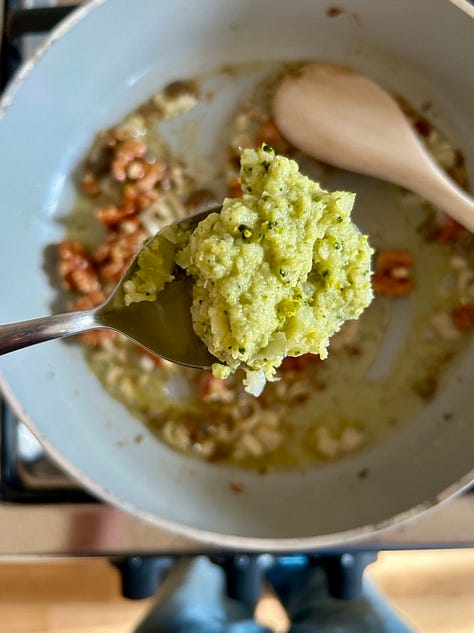
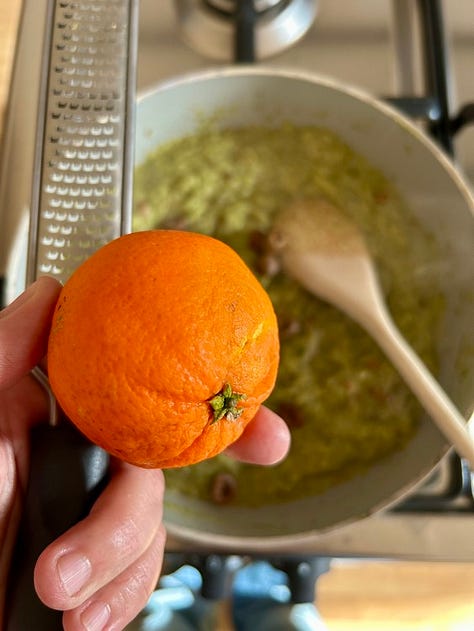
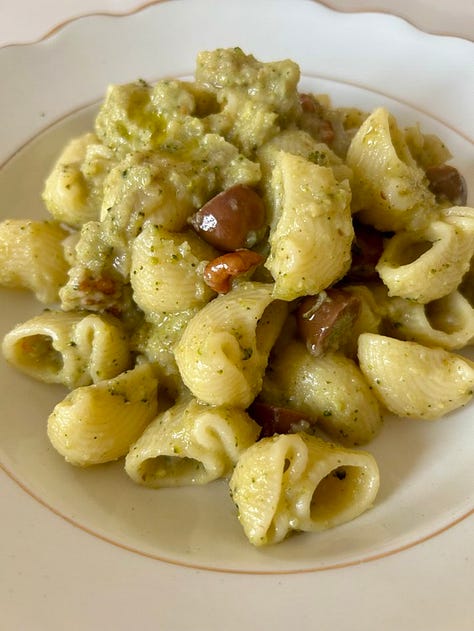
serves 4
Ingredients
300 g of boiled broccoli
1 tablespoon of olive oil + 1 tablespoon of hot water
40 g of olive oil
100 g of shallot
2 anchovies
80 g of shelled walnuts, roughly chopped
100 g of green or black olives, roughly chopped
one organic orange grated zest
salt to taste
1 cup of pasta cooking water
320 g of short pasta of your choice
Method
Set aside a few broccoli florets and blend the rest, including the stems and leaves, with one tablespoon of olive oil and one tablespoon of water. Set aside.
Remove the skin and the green core of the shallot, and then slice it thinly. Sauté gently in a pan with olive oil and a pinch of salt for a few minutes.
Add the anchovies and walnuts, slightly increase the heat, and stir for a minute to dissolve the anchovies and toast the walnuts.
Lower the heat and add the olives and broccoli cream. Cook gently for a few minutes, stirring.
Finally, season with salt and add the grated zest of half an orange, mixing one last time before turning off the heat. The sauce should be thick, which is fine.
Cook the pasta in boiling salted water, remembering to set aside a cup of this water.
While the pasta is still cooking, add a few tablespoons of the pasta cooking water at a time to make the sauce fluid but not watery to your liking. Taste, and, if needed, adjust the salt.
Toss the pasta and serve.
Lemony risotto
serves 4
Ingredients
1 small white onion (or 2 shallots, or the white part of half a leek; save the green part for other preparations)
40 g of butter (you can substitute with 30 g of olive oil or vegetable, flavorless cocoa butter)
30 g of olive oil
zest and juice of 1 organic lemon
300 g of Carnaroli rice
1 liter of vegetable broth
½ sprig of fresh rosemary, washed and dried (plus a few sprigs for garnish)
50 g of grated Parmigiano
olive oil and salt to taste
Method
Remove the skin and the green core of the onion, then finely slice it and set aside.
Melt the butter and olive oil in a large saucepan. Add the rosemary, onion, and a pinch of salt. Sauté the onion gently over low heat until it becomes translucent and soft. The process should take a few minutes.
Add the rice and stir with a wooden spoon to combine it with the onion. Toast the rice in the pan, stirring, for a few minutes over medium-high heat until it becomes translucent.
Pour the lemon juice and add the grated zest of half a lemon. Stir for a minute, then remove the rosemary.
Cook the risotto over medium-low heat by pouring the warm stock in at least 3 times, stirring well each time you add more. By doing this, the risotto will become creamier thanks to the starch released by the rice.
The risotto cooking will take about 14-16 minutes. Taste the risotto every now and then; it is ready when it's still slightly al dente (that is, the grain still has a hard soul inside).
At this point, turn off the heat, add a few tablespoons of grated Parmigiano, stir, and let it rest for a minute. Taste again and adjust with salt if needed. If it's too dry, add a few tablespoons of broth (or hot water if you've ended the broth) and stir to restore creaminess.
Sprinkle each plate with more grated lemon zest, garnish with half a small rosemary tuft, and serve immediately.
Citrus bottoni pasta
serves 4
Ingredients
Pasta dough
2 regular eggs
200 g all-purpose or 00 flour
Bottoni filling
300 g of stracchino cheese or ricotta
30 g of grated Parmigiano
grated zest of ½ orange and ½ lemon
2 teaspoons of olive oil
salt to taste
Sauce
8 shallots or one red onion
grated zest of one orange or lemon
filtered juice of one orange (or lemon)
olive oil, salt, and pepper to taste
Method
Filling
Mix all the filling ingredients in a bowl with a spoon. Transfer to a disposable piping bag and set aside in the refrigerator.
Pasta Dough
Place the flour on the cutting board and form a well in the center with your fingers.
Crack the eggs into the well.
Using a fork, gradually bring the flour toward the center to mix with the eggs.
Stir until large crumbs form. From this point on, work the dough with your hands.
Work the dough with regular wrist movements, pushing the mixture forward and bringing it back toward you for about 10 minutes until it is smooth and soft but not sticky.
Form a ball and let the dough rest for 30 minutes at room temperature, wrapped in plastic film or under a glass bowl.
You can also use the planetary mixer to make the dough.
Sauce
Set aside the grated zest to add just before serving.
Remove the skin and the green core of the shallots, slice them, and gently cook them in a pan with olive oil, citrus juice, and salt until translucent and soft.
Assembling bottoni pasta
Roll out a thin sheet using a pasta machine or a rolling pin.
Place small amounts of filling (about the size of a hazelnut) on half the dough at regular intervals.
Fold the dough over itself.
Press the pasta well around the filling, trying to push out any air. This will help prevent the buttons from breaking during cooking. If unsure, use a clean needle to poke the buttoni (only 1 time), which will help during cooking.
Use a round cutter, about 3 cm in diameter, to cut out the buttons. Leave at least 3-4 mm between the filling and the edge. Let the buttons rest at room temperature for 30 minutes.
Cook in boiling salted water until they float to the surface. Set aside a couple of ladles of the cooking water, then transfer the pasta to the saucepan using a slotted spoon.
Add a drizzle of olive oil and a little pasta cooking water, and season gently.
Finish with a light grating of orange or lemon zest (or both) and serve immediately.
From my blog, a recipe for citrus pork roast for a colorful and fragrant roast that will amaze and delight your family, HERE you will find the recipe
Let’s keep the conversation going.
Write to me at tortellinico@gmail or follow me on Instagram.
If you enjoyed this newsletter, please click on the little ❤️ below ⬇️ and share it. New subscribers can sign up here.




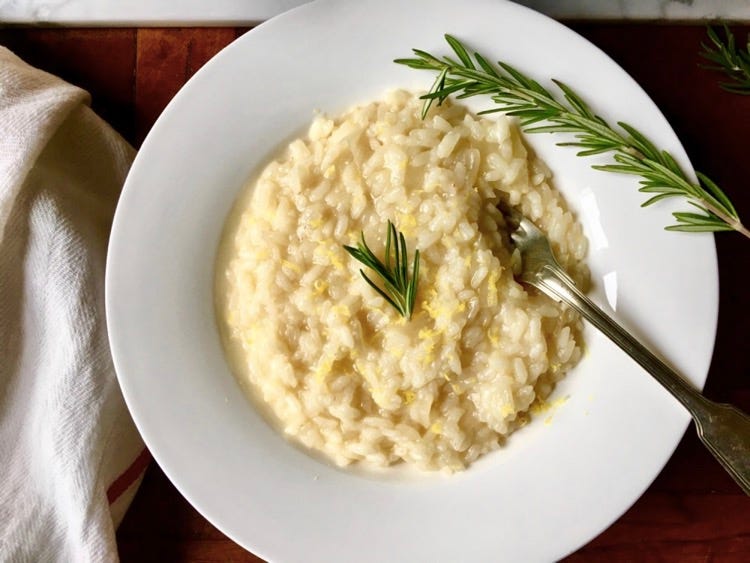
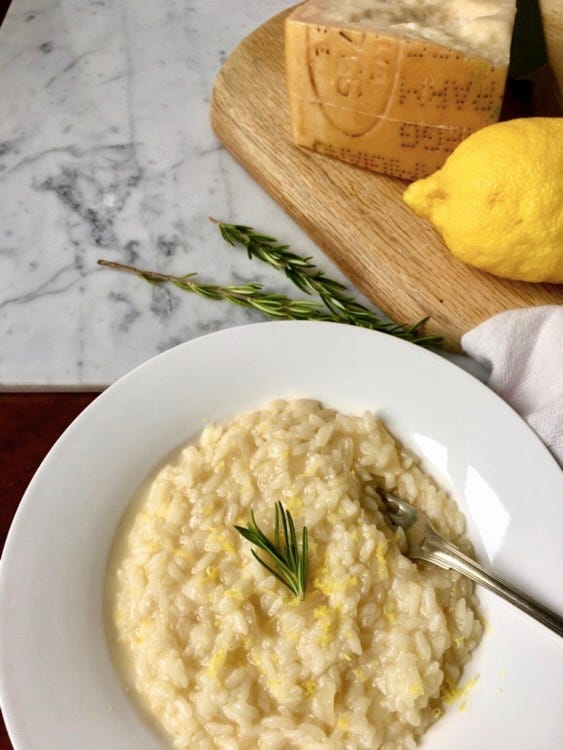
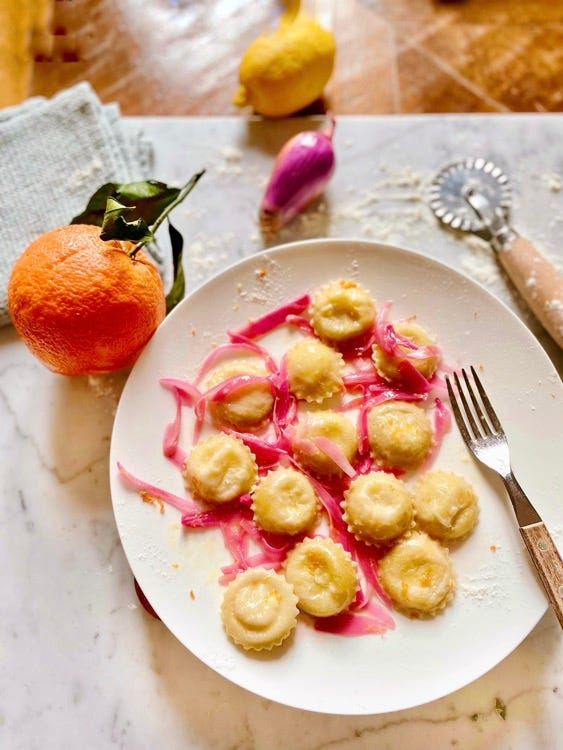

These all look wonderful! You are a lovely storyteller bringing things to life through words. Thank you.
Cara Monica, i enjoyed a lot your story. I love citrus . My dad had a lemon tree and orange tree in his garden. i remind the perfum when the trees were in bloom.
The recipes are great and very tasty, endeed . The lemon always gives a special touch to meals.
It's always a pleasure to read your fantastic blog.
Un abraccio amica🥰🥰